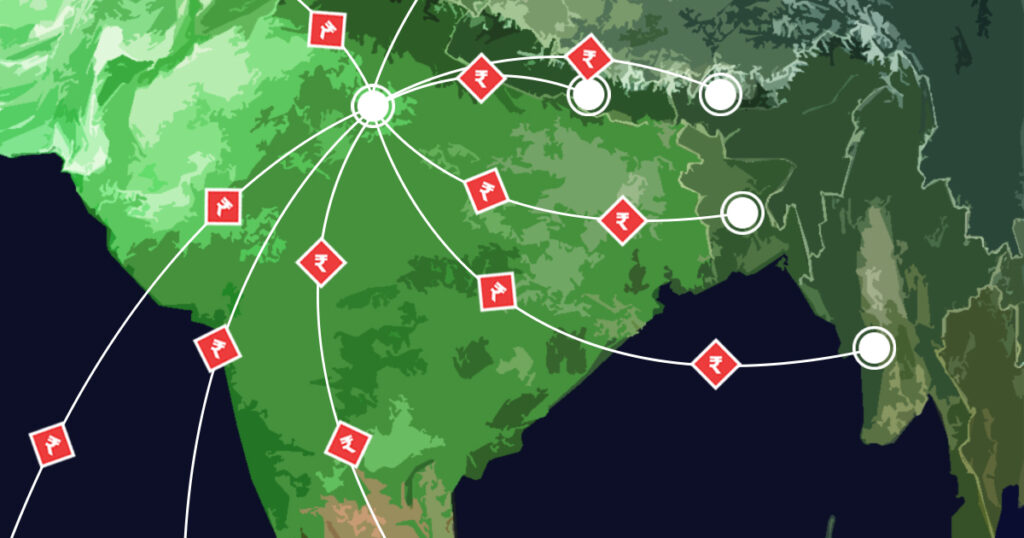
- Among all the aspects of the budget, foreign aid can give some key insights towards the priorities of the government regarding its foreign policy.
- Bhutan is set to be the top recipient of foreign aid with ₹2068.5 crores followed by Nepal with ₹700 crores. This is in continuation with the current government’s neighbourhood-first policy.
- While Sri Lanka and Africa have seen an increase in their share of aid, there is a marked decrease in the economic assistance provided by India to the Maldives and Afghanistan.
Interim budget for the year 2023-24 was announced by Nirmala Sitharaman. Being a year of general elections, this is just a stopgap budget, with the full budget announced by the next elected government. Interim budget is a budget that has been more often misused by most governments of the past. With the election on the horizon, the incumbent Government sees it as a final political push. Fiscal discipline is seldom followed. This is seen as an opportunity to announce a series of welfare schemes or rather freebie programs to attract voters in the subsequent election.
This budget was an exception to this rule; it not only maintained its fiscal discipline but also managed to expand and consolidate its ongoing welfare schemes. No populist measures were announced that might hurt the economy.
Foreign Aid
Among all the aspects of the budget, foreign aid can give some key insights towards the priorities of the government regarding its foreign policy. This particular budget is more significant as the current dispensation is predicted to win the upcoming elections by all the credible pundits in the country. So, this document can be a key indicator to assess the future geopolitical vision.
Maldives
In this budget, India reduced its foreign aid to ₹600 crore. This is around a 22% reduction compared to last year’s ₹770.9 crores. It is still about 6.8% of the total foreign aid budget which is substantial. With its continuously deteriorating relationship with India, there is little expectation for an increase in allotment unless any dramatic shift occurs.
Until recently, Maldives has been a very close ally of India. With many strategic cooperations and trade between the two. Its strategic geographical location in the seas is also one of its biggest strengths. But their newly elected current government has been not so subtle in its anti-India stance. Its overt tilt toward China and its animosity against India have been apparent from the beginning. China considers it a key part of the plan in its pursuit to expand its influence in the South China Sea.
The recent derogatory and uncalled comments by ministers of Maldives on Prime Minister Narendra Modi must also be seen in this context. Its insistence on moving the Indian Navy station out is also the continuation of this. Yet all this hasn’t been without any effects.
Along with the reduced aid, many Indians who had planned their trip to Maldives for a holiday have cancelled their booking. This comes as a blow as the tourism industry is one of the biggest sources of revenue for the country. Interestingly the finance minister in her budget speech also spoke especially about the development of Lakshadweep Islands as a holiday destination hub. It can be improved in-house alternative to the tourism experience.
PM Modi being a master in subtle messaging, his photoshoot in the beaches of Lakshadweep spoke a lot about the vision of the current government. It also signalled to the industry experts as to, which direction the wind was blowing. The Taj group has already announced their plan to start their operations there. The major hurdle to the development of the Islands was the ecological sensitivity. But with proper precautions, this government has shown that a crucial balance between environment and development can be maintained in the larger national strategic interests.
Highest Receivers
“You can choose your friends, not neighbours”. Bhutan is set to be the top recipient of foreign aid with ₹2068.5 crores followed by Nepal with ₹700 crores. This is in continuation with the current government’s neighbourhood-first policy. These two countries have been on top of the priority list for good reasons. This budget also signals the continuation of the same.
Reduction
Of all the reduction of aid compared to the previous year, none is much more surprising than Afghanistan. Until very recently, India had many projects running in that country like dams and libraries. But with the hostile and bloody takeover of the Taliban, whose government is not recognised yet; India has been very cautious in assessing the situation and indulging them. Previously, when the situation was going to extreme, India voluntarily sent out wheat, to lessen the sufferings of the people. With its border tensions regarding Durant’s line with Pakistan, it would be interesting to see the future developments.
Increase
Sri Lanka and Africa have seen an increase in their share of aid. Africa is the more interesting one, as it has not received the attention it deserves from the governments of the past. With its rich natural resources and rare earth, India needs to push to increase its relations. Africa has started to garner attention from this government. In the recent G20 summit, India successfully included the African Union in the G20 membership. Africa has much untapped potential and can be a key ally for India in the future.
(Shreyas Goutham has an M.Sc. in Psychology and serves in NIMHANS. He writes regularly on politics, society, international affairs and technology. Opinions expressed are the author’s own)
Shreyas has an M.Sc. in Psychology and serves in NIMHANS. He writes regularly on politics, society, international affairs and technology. Views expressed are the author’s own and do not necessarily reflect the views of SamvadaWorld or its staff.
